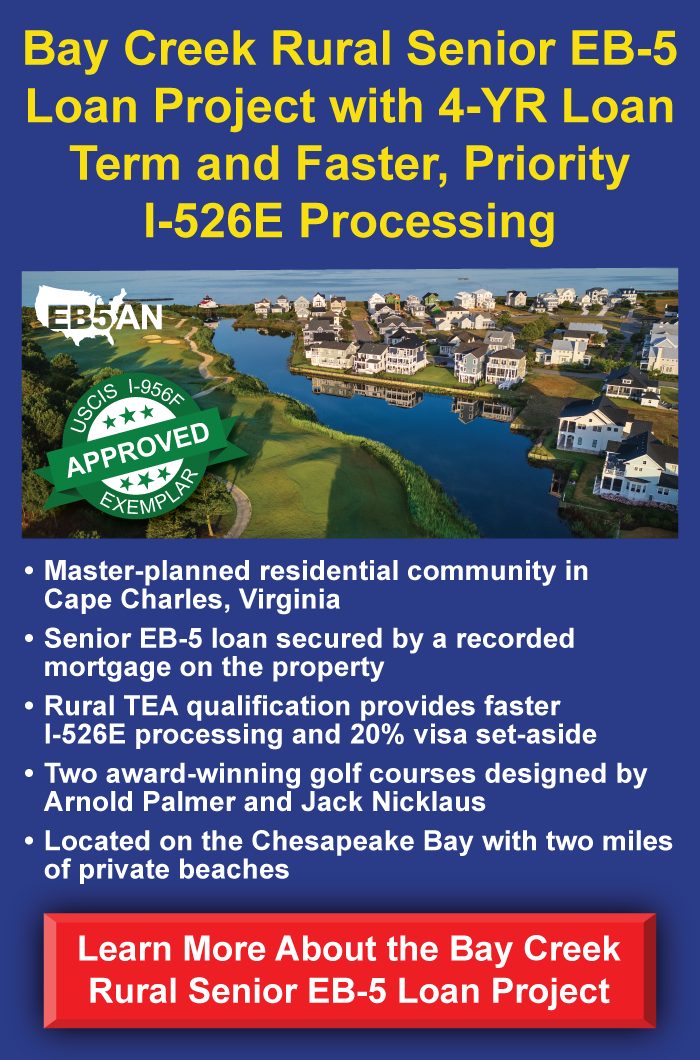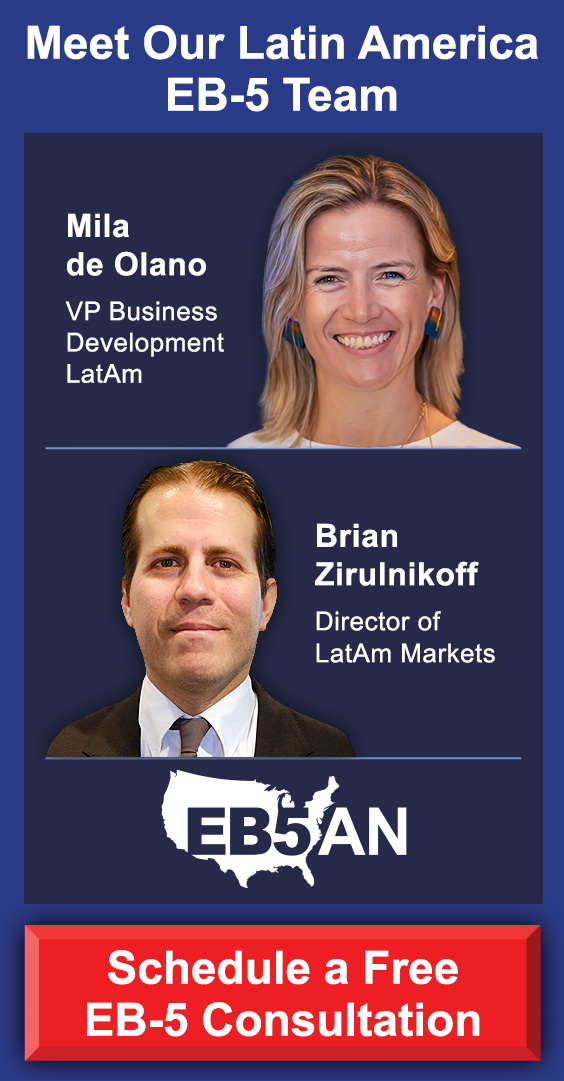In making an EB-5 investment, one of your most important considerations should be a project’s financing. An EB-5 project that’s well-capitalized and able to complete construction could result in a fast Green Card approval—not to mention the return of your invested funds.
But if an EB-5 project fails financially—and therefore does not create enough qualifying EB-5 jobs—you could end up receiving a USCIS denial and losing all or part of your capital.
No matter what EB-5 project you’re considering, EB5AN invites all prospective investors to carefully research each option, including by looking into its financials, capital structure, developer track record, and other important indicators of success.
One of the most promising real estate asset classes in 2025—especially for EB-5 investors—is the multifamily sector. Multifamily apartment developments have a particularly high market appeal and potential for significant profits.
EB5AN, for example, currently sponsors Terra Ceia, an institutional-quality multifamily project in Central Florida. Terra Ceia is being developed by The Kolter Group, one of the most successful developers in the Southeast.
When evaluating a multifamily EB-5 project, many investors look for a finalized construction loan. A construction loan, of course, is a good indicator that a project is well-capitalized.
But at what stage of development should a multifamily project typically secure the construction loan? As we’ll examine below, the construction loan is usually finalized only after all the equity has been invested.
In this article, we’ll delve into how multifamily projects are typically financed, providing valuable insights for evaluating this asset class for your EB-5 investment. Then we’ll take a look at EB5AN’s Terra Ceia multifamily project and discuss the advantages it offers to EB-5 investors.
Learn More About Terra Ceia (Equity)
Learn More About Terra Ceia (Loan)
Key Concepts of Real Estate Financing: Equity and Construction Loans
When Do Construction Loans Enter the Picture?
Construction Loans and EB-5: Third-Party Project Evaluation
EB5AN’s Terra Ceia Urban EB-5 Project: A Premier Multifamily Development
Preparing for a Successful EB-5 Investment
Key Concepts of Real Estate Financing: Equity and Construction Loans
Real estate developments are financed by a variety of sources: the developer’s own equity, construction loans, and other forms of debt such as EB-5.
Equity, one of the most substantial source of investments, is the portion of a project’s cost that is funded by ownership rather than borrowed money. This funding source represents the developer’s own capital investment in the project and serves as a financial cushion for lenders and investors.
In simple terms, equity is the money at risk from the developer itself. These are the funds the developer puts into the project—cash, land value, or other assets—to demonstrate commitment and secure financing.
The higher the developer’s equity contribution, the more confidence lenders and investors tend to have in the project’s viability.
As we’ll see below, a developer with a significant equity contribution has more “skin in the game” and, as a result, is more likely to see and finance a project through to completion. Their personal funds are, after all, at stake.
In contrast, a construction loan is short-term financing provided by a bank or lender to cover the costs of building the project. The lender typically releases the funds in stages, called “draws,” as construction progresses and the project meets milestones progressively.
Developers typically pay interest on each amount disbursed, not the full loan balance. Once construction is complete, the loan is usually paid off or refinanced into a long-term mortgage or permanent loan.
What makes EB-5 attractive to developers is its increased flexibility and reduced expense. EB-5 typically supplements traditional financing sources and is available at below-market costs.
Notably, EB-5 financing usually has lower priority in a project’s capital structure, often sitting below the more senior loans received from traditional lenders.
When Do Construction Loans Enter the Picture?
Together, developer equity and the construction loan are the main financing sources of most real estate projects: The equity covers the initial costs and secures the lender’s confidence, while the construction loan supplies the bulk of the funds needed to complete the project.
Equity typically comes into a real estate project first. The developer uses their own capital to cover initial costs, purchase the land, carry out early design and permitting, and start initial site work. This early phase is often called the “predevelopment” stage, and it’s funded entirely through equity, not construction debt.
Why does equity cover this initial stage? Major lenders generally won’t commit construction financing until key milestones—like zoning approvals, permits, and finalized budgets—are secured. The developer’s equity at this stage shows that they have a financial commitment to complete the project successfully and allows them to reach the milestones typical lenders expect.
Once the plans are finalized and the project reaches the stage where vertical construction can begin, the developer equity has likely been fully invested. At this point, the developer approaches a lender for a construction loan. The lender reviews the project’s financials, appraisals, and construction contracts to ensure it’s viable and well-managed.
The developer’s upfront equity investment serves as proof that the project already has momentum and reduces the lender’s risk. Only after this equity is in place and early progress is visible will the lender provide the construction loan, which then funds the majority of the remaining costs—materials, labor, and continued development.
So, what do these financing mechanics mean for EB-5 investors?
Construction Loans and EB-5: Third-Party Project Evaluation
Construction loans show EB-5 investors that a typical lender has deemed the project worth investing in.
It’s important to keep in mind that, as explained above, the construction loan does not arrive at the very beginning of development—it comes in once the developer’s full equity has been invested and a significant amount of the total project costs have been spent.
At that point, the land is fully purchased, design and permitting are complete, and early construction is underway.
This level of progress gives the lender tangible evidence that the project is real, properly capitalized, and advancing according to plan. The lender can then confirm that the developer has fully committed their equity, which significantly reduces perceived risk and justifies financing the remainder of the construction.
Since the project now demonstrates real value—both in the land and in the completed portion of work—the lender feels confident enough to issue the construction loan. In other words, the developer’s equity “bridges the gap” between early development and full-scale financing.
Since third-party lenders are selective in the projects and developers they are willing to lend money to, EB-5 investors can rely on their judgment of a project’s standing. As a result, EB-5 investors can use a construction loan as a milestone that reflects the likelihood of the project’s success.
EB5AN’s Terra Ceia Urban EB-5 Project: A Premier Multifamily Development
If you are leaning toward a multifamily project for your EB-5 investment, we are pleased to offer Terra Ceia, a best-in-class apartment community that is already under construction in Palmetto, Florida.
Terra Ceia is available to investors in two appealing funds: an equity fund with a high 5% preferred return and a loan structure with a short three-year investment period.
At completion, Terra Ceia will comprise a 276-unit, market-rate apartment community in Palmetto, Florida.
The project is being developed by Kolter Multifamily, a division of The Kolter Group—one of the most experienced private developers in the United States. Kolter has completed over 100 residential projects, delivering more than 27,000 units, and all EB5AN funds in Kolter projects have been either repaid or remain in good standing.
With its proven track record, strong capitalization, and extensive multifamily expertise, Kolter offers a level of certainty that few developers can match. Remarkably, in its 28-year history, Kolter has never failed to complete a project or repay a loan.
Greystar, a globally recognized property manager with more than 900,000 units under management, is expected to operate Terra Ceia once construction is complete. Greystar’s experience and operational scale will help ensure strong performance.
The project’s location in Manatee County places it in one of Florida’s fastest-growing regions. The county has committed a record-setting $2.9 billion to infrastructure and community improvements, and the population within three miles of the Terra Ceia site is projected to increase by 77% by 2028. The broader North Port–Bradenton–Sarasota metropolitan area continues to rank among the most attractive relocation destinations in the United States, consistently recognized for its economic expansion and lifestyle appeal. This growth supports strong rental demand, helping to ensure stable occupancy and long-term value for Terra Ceia’s development.
Terra Ceia Multifamily further benefits from an urban targeted employment area (TEA) designation, qualifying EB-5 investors for the reduced $800,000 minimum investment and access to a reserved set of EB-5 visas for high-unemployment projects. This designation makes Terra Ceia particularly appealing to Chinese and Indian investors seeking faster visa availability in an urban context.
The project combines this immigration advantage with sound financial fundamentals, making it a rare example of an urban EB-5 deal that offers both security and potential efficiency in processing.
As of October 2025, U.S.-based investors in Terra Ceia can adjust their immigration status immediately, remain in the U.S., and gain work and travel documents quickly.
And crucially for investors, Terra Ceia Multifamily is expected to generate a total of 640 qualifying jobs—well above the 560 jobs required for the project’s EB-5 investors. This surplus offers a substantial buffer and minimizes immigration risk by ensuring that each investor’s job creation requirement will be met.
Preparing for a Successful EB-5 Investment
We invite you to learn more about the EB-5 program and the principles for a successful investment—for both U.S. Green Cards and a prompt repayment.
As part of your research, make sure to explore the free resources, including full-length interviews with successful EB-5 investors, available from EB5AN.
And for personalized guidance, we invite you to schedule a free consultation and take the first steps toward becoming a U.S. permanent resident through EB-5.








